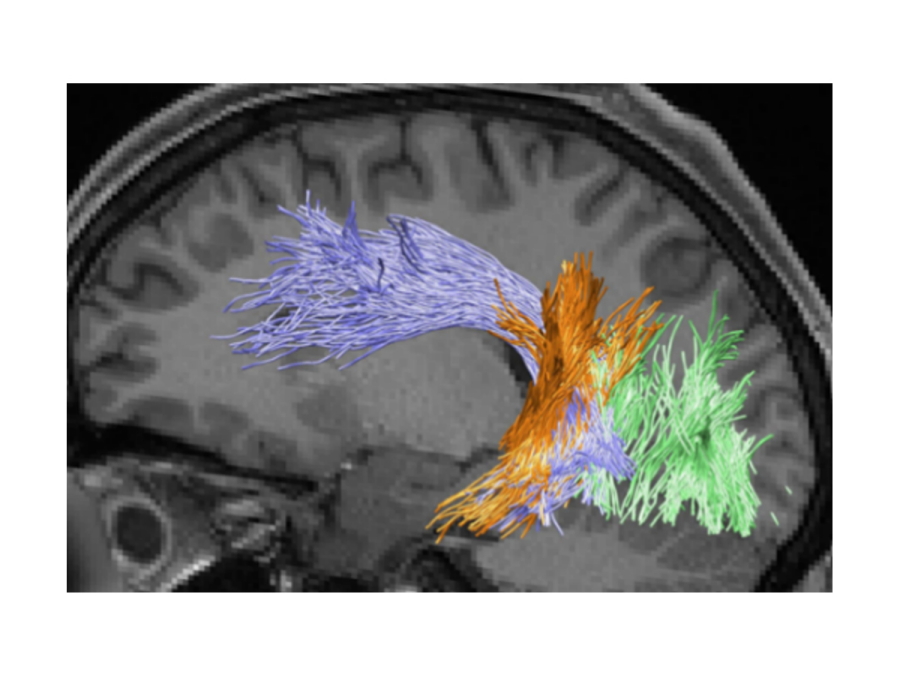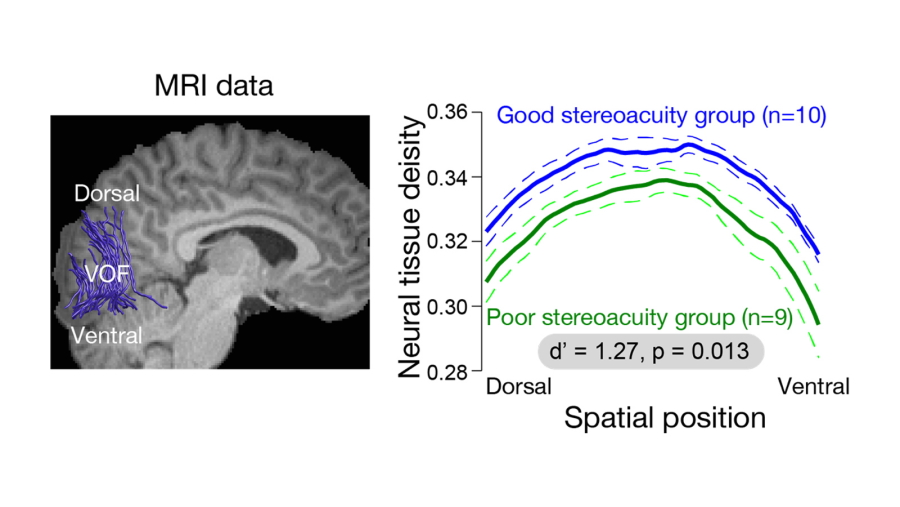White Matter Pathway and Individual Variability in Human Stereoacuity
| Journal | Proc Natl Acad Sci USA 115, 12289-12294 (2018) |
|---|---|
| Title | White Matter Pathway and Individual Variability in Human Stereoacuity |
| Laboratory | Cognitive Neuroscience Group |
Researchers in the Center for Information and Neural Networks (CiNet), the National Institute of Information and Communications Technology (NICT, President: Hideyuki Tokuda, Ph.D.), and Osaka University (President: Shojiro Nishio, Ph.D.) have identified a human white matter pathway associated with individual variability in human stereoacuity. By combining neuroimaging and psychophysical measurements, we found that the neural tissue density of the white matter pathway, the vertical occipital fasciculus (VOF), correlated with the individual variability in stereoacuity. The VOF connects the dorsal and ventral visual areas involved in stereopsis. This finding is important to understand the neural basis of dysfunction in stereopsis.
Seeing in the three-dimensional world, stereopsis, is an important visual function for our daily life. A series of previous studies have revealed that our stereopsis is established by neural processing of binocular disparity, which is the retinal image difference between the two eyes. A number of studies have investigated which brain regions are involved in such information processing. Understanding of the neural mechanisms underlying stereopsis is crucial not only for visual neuroscience but also for application in virtual reality systems.
There is one unanswered key question regarding stereopsis: why the ability of depth discrimination (stereoacuity) varies greatly among people. In fact, previous studies have reported a broad distribution of human stereoacuity. Although it is likely that such a difference is related to a difference in the neural systems, the neurobiological origin of such individual differences is unknown.
In this study, researchers in NICT and Osaka University examined the neuronal basis of individual differences in stereoacuity by combining cutting-edge neuroimaging techniques and psychophysics. We specifically focused on white matter pathways connecting distant brain areas because previous studies have demonstrated multiple brain areas in the dorsal and ventral visual areas are involved in stereopsis. We first identified trajectories of major white matter pathways related to visual processing by analyzing a diffusion MRI dataset. We then quantified neural tissues in the white matter using a quantitative MRI method. Furthermore, we estimated the stereoacuity of each individual human participant in a psychophysical experiment.
A previous study found that approximately 30% of healthy individuals have relatively lower performance in stereoacuity. Further research on stereoacuity and white matter will contribute to a method for improving our performance in stereopsis.
This paper appeared in the journal Proceedings of the National Academy of Sciences of the United States of America on November 15 (Japan Standard Time), 2018.
Abstract
Stereopsis is a fundamental visual function that has been studied extensively. However, it is not clear why depth discrimination (stereoacuity) varies more significantly among people than other modalities. Previous studies reported the involvement of both dorsal and ventral visual areas in stereopsis, implying that not only neural computations in cortical areas but also the anatomical properties of white matter tracts connecting those areas can impact stereopsis and stereoacuity. Here, we studied how human stereoacuity relates to white matter properties by combining psychophysics, diffusion MRI (dMRI), and quantitative MRI (qMRI). We performed a psychophysical experiment to measure stereoacuity, and in the same participants we analyzed the microstructural properties of visual white matter tracts based on two independent measurements, dMRI (fractional anisotropy, FA) and qMRI (macromolecular tissue volume; MTV). Microstructural properties along the right vertical occipital fasciculus (VOF), a major tract connecting dorsal and ventral visual areas, were highly correlated with measures of stereoacuity. This result was consistent for both FA and MTV, suggesting that the structural-behavioral relationship reflects differences in neural tissue density, rather than differences in the morphological configuration of fibers. fMRI confirmed that binocular disparity stimuli activated the dorsal and ventral visual regions near VOF endpoints. No other occipital tracts explained the variance in stereoacuity. In addition, the VOF properties were not associated with differences in performance on a different psychophysical task (contrast detection). These series of experiments suggest that stereoscopic depth discrimination performance is, at least in part, constrained by dorso-ventral communication through the VOF.

Example of white matter pathways

Figure 1
(Left) Vertical Occipital Fasciculus (VOF) measured using diffusion MRI in a representative human participantThe VOF (blue lines) connects the dorsal and ventral visual cortex, which are located in a posterior part of the brain.(Right) Neural tissue of the VOF and stereoacuityThere is a significant difference in the neural tissue of the VOF (vertical axis) between human participants with good (blue) and poor stereoacuity (green). The thick lines depict the mean in each group. Dotted lines are ±1 standard error of the mean (S.E.M.).
| Authors | Oishi H (1, 2), Takemura H (1, 2), Aoki SC (2), Fujita I (1, 2), Amano K (1, 2)
|
|---|---|
| PubMed | 30429321 |
